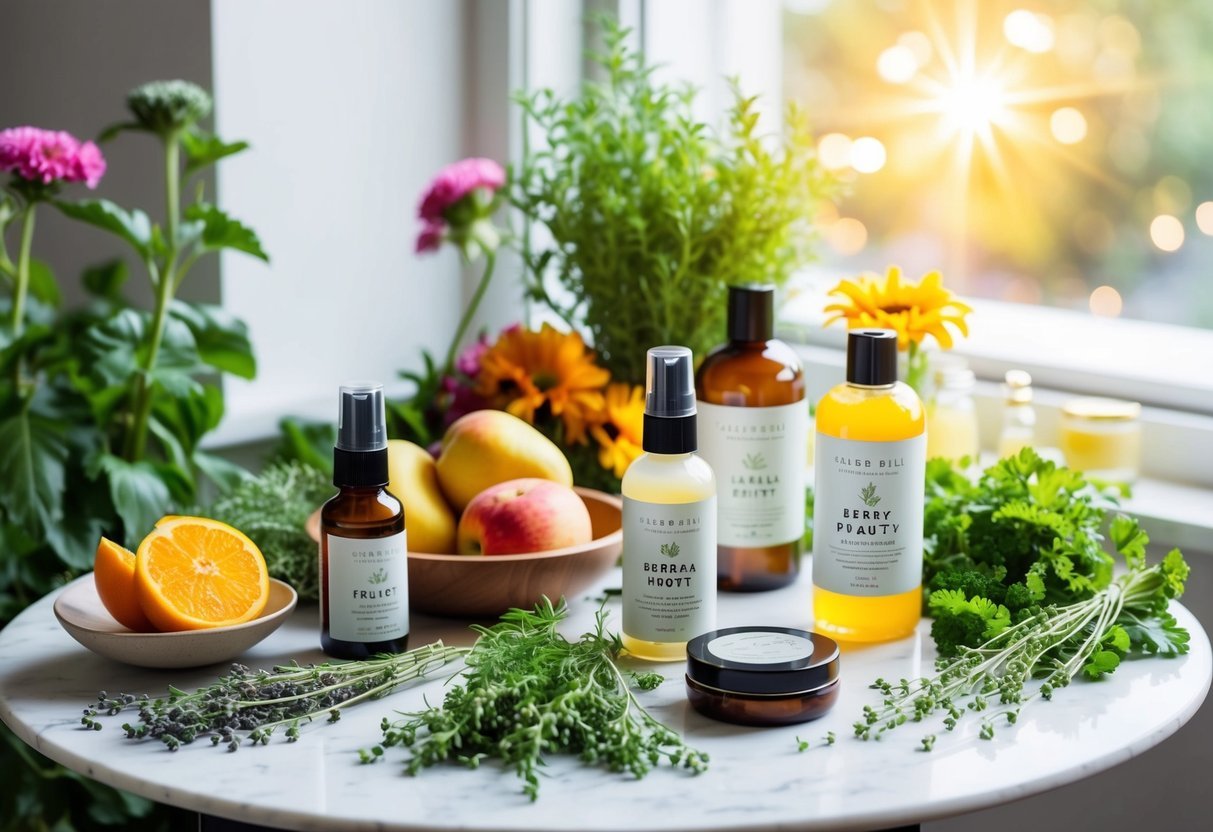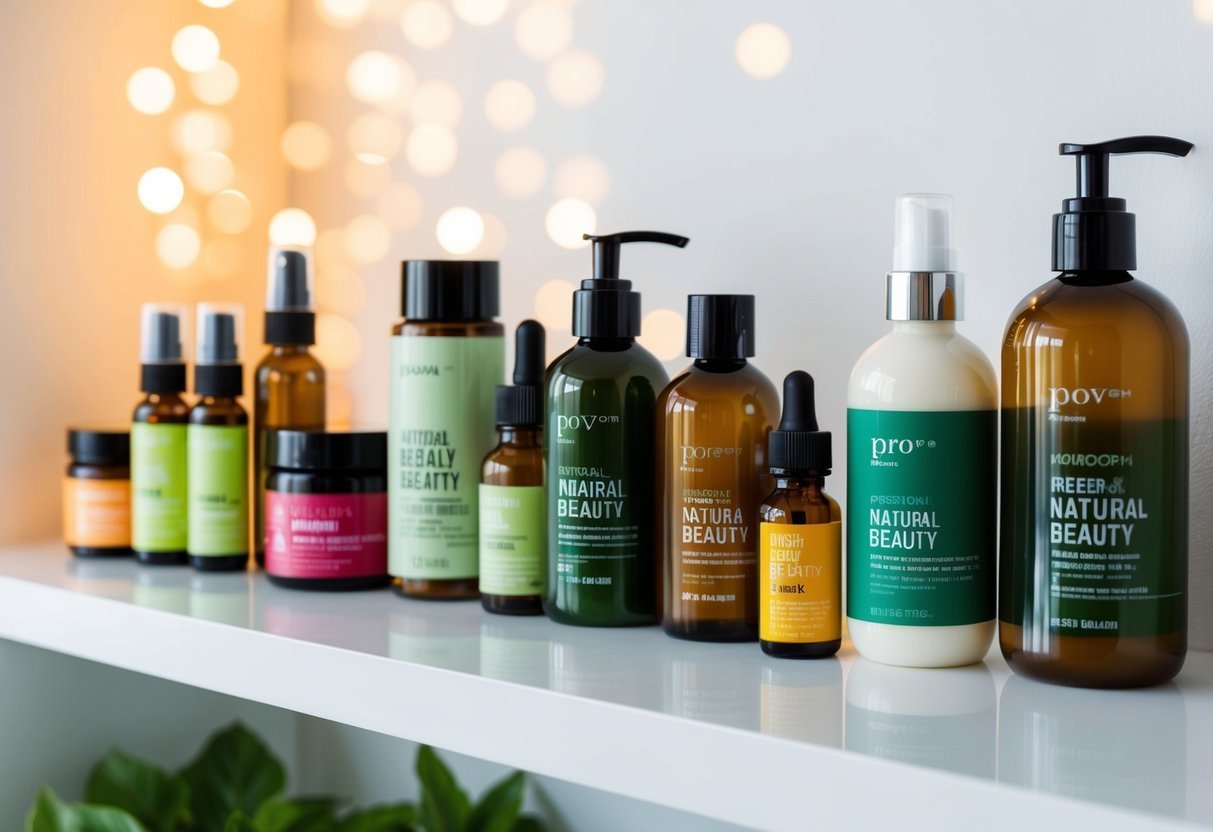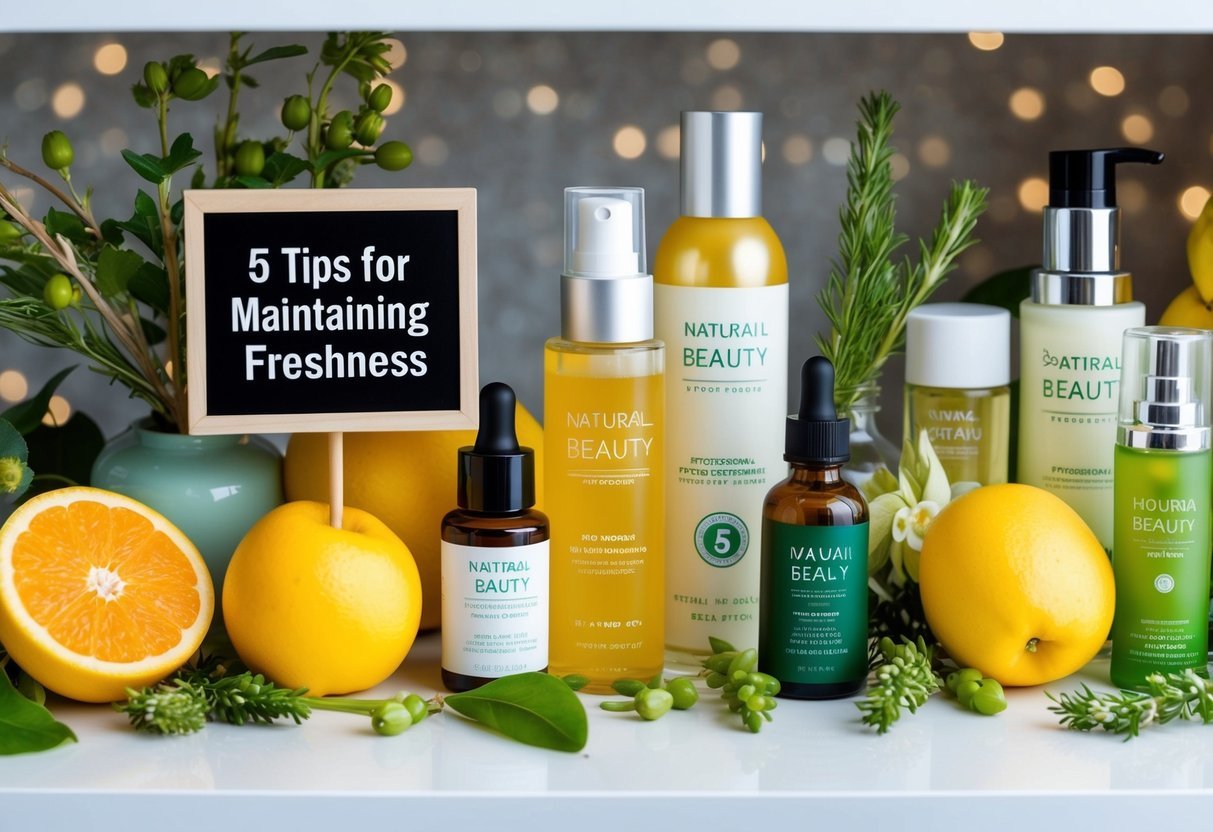Natural beauty products have gained immense popularity in recent years as consumers seek gentler, more eco-friendly alternatives to conventional cosmetics. These pure formulations often lack harsh preservatives, making proper storage and care essential for maintaining their quality and effectiveness.

Keeping our organic beauty items fresh and potent requires a bit of extra attention, but the benefits are well worth it. We’ll explore some simple yet effective strategies to extend the life of these delicate products, ensuring we get the most out of our natural skincare and makeup investments.
From temperature control to proper handling, these tips will help preserve the integrity of our favorite clean beauty essentials.
1) Store in a Cool, Dark Place
We all want our natural beauty products to stay fresh and effective. One of the best ways to achieve this is by storing them in a cool, dark place.
Heat and light can break down active ingredients in organic skincare formulas. That’s why we recommend keeping your products away from sunny windowsills or steamy bathrooms.
A bathroom cabinet or dresser drawer works well for most items. If you have space, a dedicated beauty fridge is ideal for temperature-sensitive products like face masks or eye creams.
Some items benefit from refrigeration, like aloe vera gel or cucumber toner. The cool temp keeps them extra refreshing. Just be sure to use clean hands when reaching for chilled products.
For oil-based serums and balms, a cool spot helps prevent them from going rancid too quickly. This is especially important for delicate rosehip or evening primrose oils.
We love using pretty baskets or boxes to organize our natural beauty stash. Not only does it look nice, but it also protects products from excess light exposure.
2) Use Clean Utensils
When it comes to our natural beauty products, cleanliness is key. We always make sure to use spotless utensils when dipping into our organic creams and serums.
Dirty fingers or applicators can introduce bacteria, compromising the purity of our eco-friendly formulas. We opt for small spatulas or spoons dedicated solely to scooping out product.
After each use, we wash these tools with mild soap and warm water. For extra protection, a quick spritz of rubbing alcohol helps sanitize them completely.
We’re careful to never double-dip. Once we’ve touched a utensil to our skin, it doesn’t go back in the jar. This simple habit keeps our green beauty items fresh for longer.
For liquid products, we prefer pumps or droppers over open jars. They minimize exposure to air and fingers, preserving the integrity of our plant-based ingredients.
By treating our natural skincare like the precious commodity it is, we extend its life and effectiveness. Clean tools are a small effort that makes a big difference in our eco-beauty routine.
3) Seal Tightly After Use
We can’t stress this enough – always seal your natural beauty products tightly after use. It’s a simple yet crucial step in maintaining their freshness and potency.
When we leave containers open, air and moisture can sneak in. This can lead to bacterial growth and oxidation, potentially spoiling our precious organic goodies.
For jars, we recommend screwing the lids on firmly. With pump bottles, a quick twist to lock the nozzle does the trick. Tubes should be squeezed from the bottom up, removing excess air before capping.
We’ve found that some products come with special applicators or spatulas. These are great for keeping our fingers out of the product, reducing contamination. Let’s make sure to clean these tools regularly too.
By sealing our products properly, we’re creating a barrier against environmental factors. This helps preserve the delicate natural ingredients and extends the life of our beauty staples.
4) Avoid Contamination
Keeping our natural beauty products free from contamination is crucial for maintaining their freshness and effectiveness. We always make sure to use clean tools and fingers when applying our products.
It’s a good habit to wash our hands thoroughly before dipping into any jars or containers.
We store our organic skincare items in a cool, dry place away from direct sunlight and moisture. This helps prevent the growth of bacteria and mold that can spoil our precious concoctions.
For liquid products, we opt for pump bottles or squeeze tubes instead of open jars. These packaging choices minimize exposure to air and reduce the risk of introducing impurities.
When making DIY beauty treatments, we’re extra careful to use sterilized equipment and fresh ingredients. We also prepare smaller batches more frequently rather than large amounts that might sit around for too long.
Lastly, we keep an eye on expiration dates and toss out any products that smell off or look different from when we first opened them.
5) Check Expiration Dates Regularly
Natural beauty products don’t last forever. We need to keep an eye on those expiration dates to ensure we’re using fresh, effective items.
Many of our organic goodies now come with clear “best before” or “use by” dates printed on the packaging. It’s a good idea to jot these down when we first open a product.
For items without printed dates, we can look for a little jar symbol with a number. This tells us how many months the product stays good after opening.
Different products have varying shelf lives. Our natural mascara might only last 3-6 months, while powder blush could stick around for a couple of years.
We should give our beauty stash a once-over every few months. Toss anything that’s past its prime or shows signs of going off, like changes in smell, color, or texture.
By staying on top of expiration dates, we keep our skincare routine safe and effective. Plus, it’s a great excuse to treat ourselves to some fresh, pure products!
Understanding Natural Beauty Products
Natural beauty products have gained popularity as consumers seek cleaner, gentler alternatives to conventional cosmetics. These products harness the power of nature to nourish and beautify our skin and hair. Many brands are now formulating their offerings with plant-based extracts and essential oils, ensuring that users can indulge in effective yet safe formulations. As more people become aware of the potential harmful effects of synthetic ingredients, they are increasingly motivated to boost skincare with organic ingredients that are not only healthy for the body but also environmentally friendly. This shift in consumer preference is reshaping the beauty industry, encouraging innovation and transparency in product development.
What Makes a Product ‘Natural’
Natural beauty products are typically made from plant-based ingredients and minerals. They avoid synthetic chemicals, artificial fragrances, and harsh preservatives. We look for products that are:
• Free from parabens, phthalates, and sulfates
• Cruelty-free and not tested on animals
• Made with organic or wildcrafted botanicals
• Packaged in eco-friendly materials
Many brands use cold-pressed oils, herbal extracts, and essential oils as active ingredients. It’s important to read labels carefully, as “natural” isn’t a regulated term. We prefer products with short ingredient lists and recognizable components.
Common Ingredients and Their Benefits
Natural beauty products often feature these nourishing ingredients:
- Coconut oil: Moisturizes and has antimicrobial properties
- Aloe vera: Soothes and hydrates skin
- Shea butter: Rich in vitamins and fatty acids for deep moisture
- Jojoba oil: Mimics our skin’s natural oils
- Green tea: Packed with antioxidants to fight aging
We love using rosehip oil for its vitamin C content and ability to brighten skin. Honey is another favorite for its antibacterial and humectant properties. Many products also include plant extracts like chamomile for calming or calendula for healing.
Key Tips for Preservation
Keeping natural beauty products fresh requires some simple but effective strategies. We’ve found two key approaches that make a big difference in extending shelf life and maintaining quality.
Proper Storage Solutions
We always store our natural cosmetics in cool, dark places away from direct sunlight and heat. A medicine cabinet or drawer works great. For extra sensitive items, we pop them in the fridge.
It’s crucial to keep lids tightly closed to prevent air and bacteria from getting in.
We use clean, sterilized containers when making homemade products. For store-bought items, we avoid dipping fingers directly into jars – a small spatula or spoon keeps things hygienic. We also pay attention to expiration dates and toss anything that smells off or changes consistency.
Using Natural Preservatives
While we love pure ingredients, some natural preservatives can really boost longevity.
Vitamin E oil is one of our favorites – just a few drops help prevent rancidity in oil-based products.
For water-based formulas, we sometimes add grapefruit seed extract or rosemary extract.
Essential oils like tea tree, lavender, and lemon can also have antimicrobial effects. We’re careful not to overdo it though, as too much can be irritating.
When making DIY products, we always research proper usage rates. For extra safety, we often keep our homemade creams and lotions in the fridge and use them within a few weeks.
Identifying Signs of Expiry

Keeping our natural beauty products fresh is crucial for both safety and effectiveness. Let’s explore how to spot when they’ve passed their prime.
Changes in Texture and Color
We’ve all been there – reaching for our favorite organic face cream only to find it’s not quite right.
Texture changes are a big red flag. If our once-smooth lotion feels grainy or separated, it’s time to say goodbye.
Color shifts are another telltale sign. Has that vibrant green clay mask turned a murky brown? That’s nature’s way of saying it’s done its time.
For oil-based products, we should watch for cloudiness or separation. Clear oils turning cloudy often mean they’ve oxidized.
With balms and butters, a gritty texture might indicate the natural ingredients are breaking down.
Unusual Smells to Watch Out For
Our noses are powerful tools for detecting expired beauty products.
Fresh, natural scents fading or changing is a clear indicator. If our lavender-scented body oil starts smelling more like old cooking oil, it’s past its prime.
Rancid odors are a definite no-go. This is especially true for products containing nut oils or butters. A sharp, sour smell in our shea butter lip balm? Time to toss it.
For unscented products, any noticeable odor is suspect.
We should also be wary of musty or moldy smells, particularly in water-based products like toners or mists. These could indicate bacterial growth, which is a big no-no for our skin.
Frequently Asked Questions

Natural beauty routines can seem daunting at first. We’ve compiled some common questions to help demystify the process and guide you toward healthier, glowing skin.
How can I keep my skin looking fresh with natural remedies?
We love using chilled tea bags to reduce puffy eyes. Try mixing raspberries with coconut oil for brighter lips. Simple yoga poses can give your face a natural lift. These easy DIY treatments use pure ingredients you might already have at home.
What are the essential steps for a daily skin care routine?
We recommend starting with a gentle oil cleanser to purify your skin. Follow up with a natural toner like herbal-infused water. Then, apply a nourishing face oil or cream. Don’t forget sun protection! A few times a week, add exfoliation and a face mask for extra pampering.
How do you keep homemade beauty products fresh without preservatives?
We suggest making small batches and using them quickly. Keep your concoctions in the fridge when possible. Add natural preservatives like vitamin E oil or rosemary extract. Also, always use clean tools when scooping out product to avoid introducing bacteria.
What’s the best way to store DIY skin care concoctions?
We prefer airtight containers made of dark glass or opaque materials. This protects ingredients from light and air exposure. Store in a cool, dry place away from direct sunlight. The bathroom isn’t ideal due to humidity, so try a bedroom drawer or kitchen cabinet instead.
Can natural ingredients improve my skin’s health and how?
Absolutely! We’ve seen amazing results with ingredients like jojoba oil for balancing sebum production. Vitamin C-rich foods brighten skin tone when applied topically. Meanwhile, aloe vera soothes irritation and redness. Many plants also contain antioxidants that fight free radical damage and signs of aging.
What skincare habits should I adopt for a glowing complexion?
We can’t stress enough the importance of staying hydrated and eating a nutrient-rich diet.
Get enough sleep and manage stress levels.
Cleanse your face morning and night. Exfoliate gently 1-2 times a week.
Apply a facial oil or serum daily. And always, always wear sunscreen!

